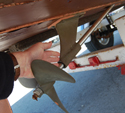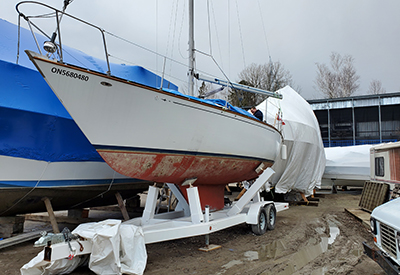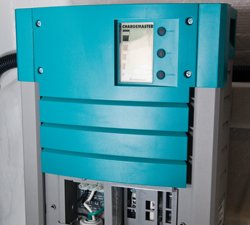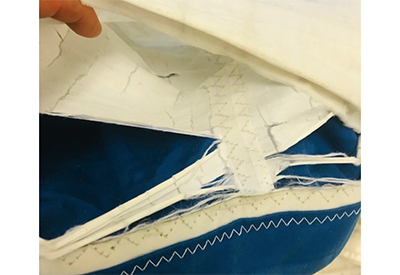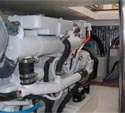Going Electric to Cruise Lake Ontario: A family ditches the diesel

Story and photos by Matt Bera
We settled Svala into what my family and I had come to think of as the most desirable anchorage on Lake Ontario, on a sunny summer afternoon. With an abandoned settlement, an old schoolhouse full of swallows, giant snakes and a rum-running past, Main Duck Island had it all. That we had to sail past the Psyche Shoal, a magnetic disturbance, and into the middle of the rumoured Marysburgh Vortex made an even better sea story. It had taken us two attempts, two years, two boats and a new sort-of experimental engine to get there.
Svala at anchor
We had been convinced to turn back on the same trip almost exactly a year before when we were delayed and then beaten back by a series of thunderstorms and the tail end of a moderately destructive tornado. I grew up sailing and had some experience as a youth on sail training ships, but neither my wife nor my then 9-year-old daughter had ever spent time on a boat before we bought our much loved Cherubini Hunter 25 four years earlier. That boat changed our lives, but as we paced the dock in Cobourg waiting for a better wind to take us back to Toronto, it also occurred to us that we might need something a little more robust if we hoped to cruise too far from our home waters in Humber Bay. As we waited, my eyes kept turning to what looked like the prettiest boat in the harbour. A little googling told me that it was a Contessa 26. A little more reading convinced me that it was just the thing we needed to sail the Great Lakes with a family of 3 or 4. By the Fall we had found and bought one of our own and started to refit her.
 There were the usual problems with buying and transporting an older boat, but the one thing that really worried me was the inboard diesel engine. I knew that the 10hp Yanmar it came with had a reputation as a tough and reliable motor, but it scared me more than a little. I was in my mid 40’s but had never owned a car, motorbike or powered lawnmower before we got a 2-stroke outboard with the Hunter. My one non-negotiable condition for buying a first boat had been that I would not buy anything with an inboard engine. Even then we were not very happy and switched to a propane outboard after we watched a family of baby ducks slowly expire in oily water over the course of a weekend.
There were the usual problems with buying and transporting an older boat, but the one thing that really worried me was the inboard diesel engine. I knew that the 10hp Yanmar it came with had a reputation as a tough and reliable motor, but it scared me more than a little. I was in my mid 40’s but had never owned a car, motorbike or powered lawnmower before we got a 2-stroke outboard with the Hunter. My one non-negotiable condition for buying a first boat had been that I would not buy anything with an inboard engine. Even then we were not very happy and switched to a propane outboard after we watched a family of baby ducks slowly expire in oily water over the course of a weekend.
Family accommodations down below
We didn’t buy a sailboat to help pollute or degrade the lakes, and we talked vaguely about one day running an electric engine. It would be clean, quiet, and easy for someone with no mechanical aptitude to maintain. On the other hand, it would be an expensive investment, a little experimental, and not so easy to charge with no shore power on our floating mooring at the Toronto Sailing and Canoe Club.
Our decision was helped along when we were unable to start or run the diesel to winterize it despite the advice and help of sailors that had maintained similar engines for years. A visit from a diesel mechanic, a long list of work that needed to be done, and the fact that the old engine would need to be pulled out and re-mounted anyway helped us decide. We were going electric.
Going electric
We settled on a 48-volt, 10-kilowatt Electric Yacht QuietTorque 10.0 Sport. Electric Yacht specializes in repowering sailboats and includes fittings meant to work with the old shaft coupling and engine mounts. They had also already repowered two Contessa 26s and could show us photos of the results. Maybe most importantly, they were responsive to our initial inquiries when other companies we reached out to were not. It would be powered by four 12v, 200ah Volthium lithium iron (LifePo4) batteries wired in series to get about 53v. In theory, we could get somewhere between 74 nautical miles on flat seas at 2kn or 9 at 5.9kn, but in practice, I am not sure I would want to test this.
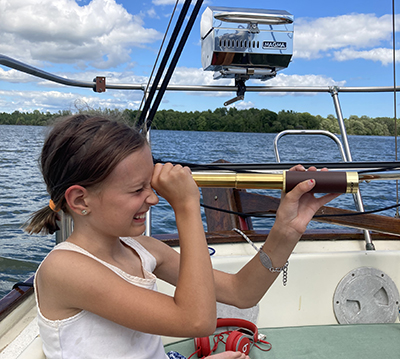 A useful display panel connected to the motor shows the charge level on the batteries as well as how long it will last at the current speed. A comparison with a multimeter seems to show that the display underestimates the remaining charge, but I am a little conservative and pessimistic anyway, so I am comfortable with this. We also bought a 300-watt solar array for use on the mooring and stored below most of the time and a charger that runs on shore power for times we are visiting marinas while cruising.
A useful display panel connected to the motor shows the charge level on the batteries as well as how long it will last at the current speed. A comparison with a multimeter seems to show that the display underestimates the remaining charge, but I am a little conservative and pessimistic anyway, so I am comfortable with this. We also bought a 300-watt solar array for use on the mooring and stored below most of the time and a charger that runs on shore power for times we are visiting marinas while cruising.
Nine-year-old on watch
There was a lot of skepticism about this decision around our club.
“If it ain’t broke, don’t fix it” (it was kind of broke already…).
“You’ll never get the same range with batteries. I could probably get 500km on my diesel tanks” (an odd thing to want a sailboat to do…)
And, most often, “The technology just isn’t there yet”.
The installation will be described in detail in the follow-up article coming in the December 2022 issue of Canadian Yachting, but let’s just say there were a few bumps along the way. After launch, a strange noise in the battery compartment made me question how sure I was that the LiFePo4 batteries absolutely, positively, did not explode until the manufacturer could assure me and carefully lead me through a maintenance check. Another noise that sounded like Curly making “whoop whoop whoop whoop” noises in an old Three Stooges film caused some concern as well until we decided that it was the noise of the feathering prop at certain speeds and conditions that would normally be drowned out by the sound of the engine. We are still having some problems getting the maximum out of our solar array.
 But then we were off. Aside from running tests on the engine and a five-day trip that I took by myself as a shakedown cruise, we had not really used the engine yet as we started learning how to sail Svala over the next three weeks.
But then we were off. Aside from running tests on the engine and a five-day trip that I took by myself as a shakedown cruise, we had not really used the engine yet as we started learning how to sail Svala over the next three weeks.
The old diesel lived under the companionway
The engine was there when we needed it, and we ended up using it more than we had expected when we were planning this and sitting by the wood stove with a bottle of wine in the winter. It drove us for hours at 4kn when the combination of a dead calm, strangely rolling swells, stable flies and a Southern Ontario heat alert made us give up on the sails. It was there for the last few miles into the wind to get to a sheltered port. I could switch it on and get 2000 rpm in under two seconds when a jibe went wrong as we tried to sail into a club when we should have motored anyway, or when a particularly murderous ferry left the dock just as we crossed its path. We could easily get up to speed in a few moments and we fueled a lot of talk on the dock about how quickly she moved when I accidentally banged the throttle with my foot and sent us rocketing backwards.
We were out for a total of 19 days, including three final days lazing on Centre Island to round off the trip. We sailed something like 300 miles in 13 days and over 100 hours of travel from Toronto around the Bay of Quinte, out to Main Duck and back, then home through the outside passage. We used the equivalent of 2 full charges on the batteries and were easily able to keep them topped up by plugging into shore power for a few hours in the evenings when we were at a marina. The motor has a total of 19 hours on it now, but this includes an earlier trip to Cobourg, some lengthy testing, and some weekend trips near our home port.
The only time the range and charge played a part in a decision we made was when we had already decided to give up on beating through 20kn winds around Prince Edward County and were debating where to put in. This was only part of a calculation that included steep, almost spiteful, waves, a wet crew, doubts about the distance we would need to go upwind and confusion about how to navigate around Waupoos Island. In the end, we made for the more familiar (and downwind) Prinyers Cove. If we had known that we had a much longer range it might have influenced our decision, but I am not sure we would have changed our minds.
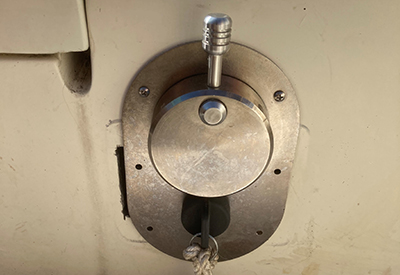 As far as our needs were concerned, the technology was “there” for cruising Lake Ontario. This electric motor would certainly meet the needs of most, if not all, day and weekend sailors on a similarly sized boat.
As far as our needs were concerned, the technology was “there” for cruising Lake Ontario. This electric motor would certainly meet the needs of most, if not all, day and weekend sailors on a similarly sized boat.
This is the Electric Yachts control. One control and the key – simplicity itself. The control is an on-off key switch and the lever takes you forward or into reverse with almost no delay.
The bad news is that the marketing and integration of the necessary components is not really ready yet. In our experience, the electric motor, battery and solar sectors were still more characterized by enthusiasm and the specialized knowledge of innovators rather than fully developed business models marketing to people that would not know about peukert exponents offhand. Worse, they all worked more or less separately.
Most boat yards in our region told us that they had had several inquiries about installing electric engines but did not know how to do it, and we needed help from Electric Yachts to find Andrew (McDonald of Lakeside Marine) to do the installation.
Motor manufacturers know something about batteries but did not recommend or sell them together.
Battery manufacturers knew something about electric motors but could not speak to how the specific proprietary systems would work together.
The first marine solar dealer we worked with had experience with lower voltage systems for house batteries but recommended and sold us an array that by definition could not handle our bigger power needs and then blamed us for not having done the research ourselves.
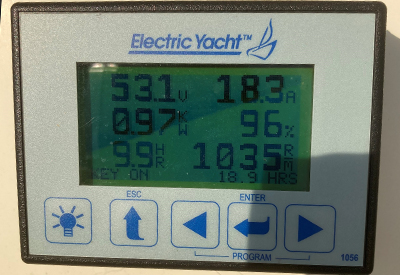 We are happy with the Electric Yacht engine and would recommend it to anyone, but if I am honest, we might have thought twice if we had known how difficult and time-consuming it would be to source the right batteries and solar components with any confidence. It also demanded the patience of Job from our installer, who had to suffer through proposals for multiple power options and configurations.
We are happy with the Electric Yacht engine and would recommend it to anyone, but if I am honest, we might have thought twice if we had known how difficult and time-consuming it would be to source the right batteries and solar components with any confidence. It also demanded the patience of Job from our installer, who had to suffer through proposals for multiple power options and configurations.
This is the Electric Yachts control panel.
This might not be unusual with newer technologies. Michelin Tires had to publish a handbook to help people through similar complications in the early days of the automotive age that eventually evolved into the famous guide to fine dining after gas, parts, and mechanics became widespread and standardized. I don’t have much trouble imagining a similar process as electric becomes more widespread. Manufacturers, dealers, or contractors that are able to sell and install integrated systems, with a few options for things like the type of battery, would make the process of repowering with electric much more accessible. Torqeedo offers some packages now, and might be leading the way for the sector.
Almost instant, clean, quiet, and reliable power might even change the way we sail. Most sailors value being able to harness the wind and waves. It’s why we have sailboats instead of cabin cruisers. On the other hand, coming into our club under sail always felt a bit risky and has earned some grave looks in other marinas we have visited. We also sometimes motored in conditions where we might have sailed if we knew that we would be able to engage the engine the moment we needed it. Our contact at Electric Yacht told us that the motor would change our seamanship. We assumed that we would have to improve it to compensate for the power and range of a diesel. Instead, the electric motor is opening up new opportunities to practise more traditional sailing. My biggest worry now is that the 10-year-old portion of our crew is lobbying to be able to sail the boat in by herself, now that we have a good “plan B”. What could go wrong?

